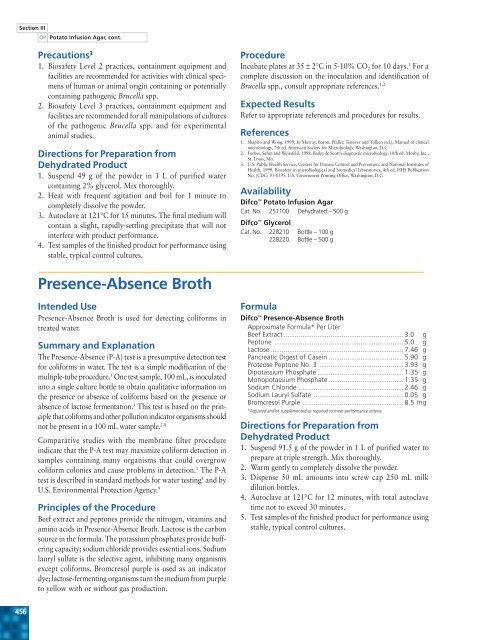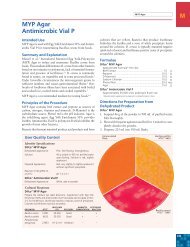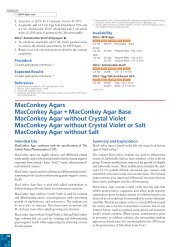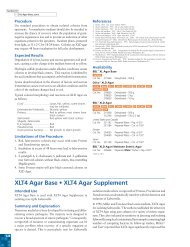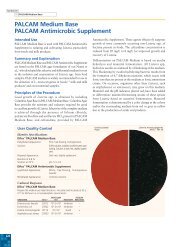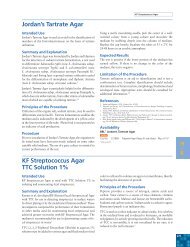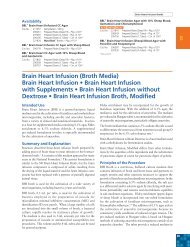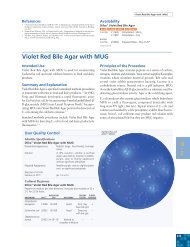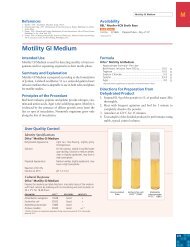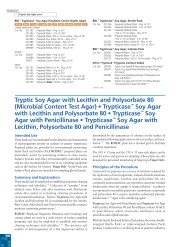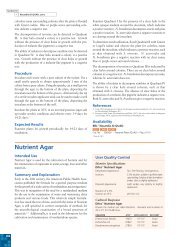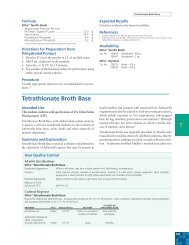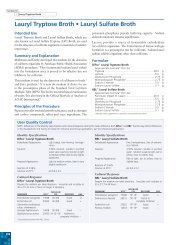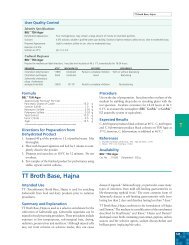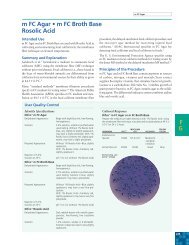Presence-Absence Broth - BVA Scientific
Presence-Absence Broth - BVA Scientific
Presence-Absence Broth - BVA Scientific
- No tags were found...
You also want an ePaper? Increase the reach of your titles
YUMPU automatically turns print PDFs into web optimized ePapers that Google loves.
Section IIIOP Potato Infusion Agar, cont.Precautions 31. Biosafety Level 2 practices, containment equipment andfacilities are recommended for activities with clinical specimensof human or animal origin containing or potentiallycontaining pathogenic Brucella spp.2. Biosafety Level 3 practices, containment equipment andfacilities are recommended for all manipulations of culturesof the pathogenic Brucella spp. and for experimentalanimal studies.Directions for Preparation fromDehydrated Product1. Suspend 49 g of the powder in 1 L of purified watercontaining 2% glycerol. Mix thoroughly.2. Heat with frequent agitation and boil for 1 minute tocompletely dissolve the powder.3. Autoclave at 121°C for 15 minutes. The final medium willcontain a slight, rapidly-settling precipitate that will notinterfere with product performance.4. Test samples of the finished product for performance usingstable, typical control cultures.ProcedureIncubate plates at 35 ± 2°C in 5-10% CO 2 for 10 days. 1 For acomplete discussion on the inoculation and identification ofBrucella spp., consult appropriate references. 1,2Expected ResultsRefer to appropriate references and procedures for results.References1. Shapiro and Wong. 1999. In Murray, Baron, Pfaller, Tenover and Yolken (ed.), Manual of clinicalmicrobiology, 7th ed. American Society for Microbiology, Washington, D.C.2. Forbes, Sahm and Weissfeld. 1998. Bailey & Scott’s diagnostic microbiology, 10th ed. Mosby, Inc.,St. Louis, Mo.3. U.S. Public Health Service, Centers for Disease Control and Prevention, and National Institutes ofHealth. 1999. Biosafety in microbiological and biomedical laboratories, 4th ed. HHS PublicationNo. (CDC) 93-8395. U.S. Government Printing Office, Washington, D.C.AvailabilityDifco Potato Infusion AgarCat. No. 251100 Dehydrated – 500 gDifco GlycerolCat. No. 228210 Bottle – 100 g228220 Bottle – 500 g<strong>Presence</strong>-<strong>Absence</strong> <strong>Broth</strong>Intended Use<strong>Presence</strong>-<strong>Absence</strong> <strong>Broth</strong> is used for detecting coliforms intreated water.Summary and ExplanationThe <strong>Presence</strong>-<strong>Absence</strong> (P-A) test is a presumptive detection testfor coliforms in water. The test is a simple modification of themultiple-tube procedure. 1 One test sample, 100 mL, is inoculatedinto a single culture bottle to obtain qualitative information onthe presence or absence of coliforms based on the presence orabsence of lactose fermentation. 1 This test is based on the principlethat coliforms and other pollution indicator organisms shouldnot be present in a 100 mL water sample. 2-8Comparative studies with the membrane filter procedureindicate that the P-A test may maximize coliform detection insamples containing many organisms that could overgrowcoliform colonies and cause problems in detection. 1 The P-Atest is described in standard methods for water testing 1 and byU.S. Environmental Protection Agency. 9Principles of the ProcedureBeef extract and peptones provide the nitrogen, vitamins andamino acids in <strong>Presence</strong>-<strong>Absence</strong> <strong>Broth</strong>. Lactose is the carbonsource in the formula. The potassium phosphates provide bufferingcapacity; sodium chloride provides essential ions. Sodiumlauryl sulfate is the selective agent, inhibiting many organismsexcept coliforms. Bromcresol purple is used as an indicatordye; lactose-fermenting organisms turn the medium from purpleto yellow with or without gas production.FormulaDifco <strong>Presence</strong>-<strong>Absence</strong> <strong>Broth</strong>Approximate Formula* Per LiterBeef Extract ................................................................ 3.0 gPeptone ..................................................................... 5.0 gLactose ....................................................................... 7.46 gPancreatic Digest of Casein ........................................ 5.90 gProteose Peptone No. 3 ............................................. 3.93 gDipotassium Phosphate .............................................. 1.35 gMonopotassium Phosphate ........................................ 1.35 gSodium Chloride ........................................................ 2.46 gSodium Lauryl Sulfate ................................................ 0.05 gBromcresol Purple ...................................................... 8.5 mg*Adjusted and/or supplemented as required to meet performance criteria.Directions for Preparation fromDehydrated Product1. Suspend 91.5 g of the powder in 1 L of purified water toprepare at triple strength. Mix thoroughly.2. Warm gently to completely dissolve the powder.3. Dispense 50 mL amounts into screw cap 250 mL milkdilution bottles.4. Autoclave at 121°C for 12 minutes, with total autoclavetime not to exceed 30 minutes.5. Test samples of the finished product for performance usingstable, typical control cultures.456
<strong>Presence</strong>-<strong>Absence</strong> <strong>Broth</strong>, cont.User Quality ControlIdentity SpecificationsDifco <strong>Presence</strong>-<strong>Absence</strong> <strong>Broth</strong>Dehydrated Appearance: Beige, free-flowing, homogeneous.Solution:3.05% solution, soluble in purifiedwater. Solution is purple, clear to veryslightly opalescent.Prepared Appearance: Purple, clear to very slightly opalescent,without significant precipitate.Reaction of 3.05%Solution at 25°C: pH 6.8 ± 0.2Cultural ResponseDifco <strong>Presence</strong>-<strong>Absence</strong> <strong>Broth</strong>Prepare <strong>Presence</strong>-<strong>Absence</strong> <strong>Broth</strong> in triple strength solution (9.15%).Sterilize in 50 mL quantities in milk dilution bottles with capacity greaterthan 150 mL. Add 100 mL of drinking water after medium is sterilizedand cooled to room temperature. Inoculate bottles with the test organisms.Incubate bottles for 18-48 hours at 35 ± 0.5°C.<strong>Presence</strong>-<strong>Absence</strong> <strong>Broth</strong>OPORGANISM ATCC INOCULUM CFU RECOVERY COLOR CHANGEEnterococcus faecalis 29212 10 2 -10 3 Partial inhibition to fair No change to slight yellowEscherichia coli 25922 10 2 -10 3 Good Yellow with or without gas productionEscherichia coli 13762 10 2 -10 3 Good Yellow with or without gas productionPseudomonas aeruginosa 27853 10 2 -10 3 Partial inhibition to fair No changeProcedure1. Collect water samples as described in recommended procedures.1,92. Inoculate 50 mL of the sterile triple strength P-A <strong>Broth</strong> with100 mL of the water sample.3. Invert the bottle a few times to achieve an even distributionof the medium throughout the test sample.4. Incubate at 35 ± 0.5°C.5. Inspect for acid and gas production after 24 and 48 hoursof incubation.Expected ResultsA distinct yellow color indicates lactose fermentation, an acidreaction. Gas production can be observed by a foaming reactionwhen the bottle is gently shaken. Any amount of gas and/oracid is a positive presumptive test requiring confirmation. 1Report results as positive or negative for coliforms per 100mL of sample.Confirmation and differentiation of coliforms detected by theP-A test may be achieved by use of appropriate confirmatorymedia, incubation times and temperatures as outlined inappropriate references. 1,9Limitations of the Procedure1. The P-A test is only a presumptive test for coliforms.2. Extending the P-A test incubation period to 72 or 96 hourswill allow isolation of other indicator organisms. However,indicator bacteria isolated after 48 hours incubation maynot be considered for regulatory purposes.References1. Clesceri, Greenberg and Eaton (ed.). 1998. Standard methods for the examination of water andwastewater, 20th ed. American Public Health Association, Washington, D.C.2. Weiss and Hunter. 1939. J. Am. Water Works Assoc. 31:707.3. Clark. 1968. Can. J. Microbiol. 14:13.4. Clark. 1969. Can. J. Microbiol. 15:771.5. Clark and Vlassoff. 1973. Health Lab. Sci. 10:163.6. Clark and Pagel. 1977. Can. J. Microbiol. 23:465.7. Clark. 1980. Can. J. Microbiol. 26:827.8. Clark, Burger and Sabatinos. 1982. Can. J. Microbiol. 28:1002.9. Federal Register. 1989. National primary drinking water regulations; total coliforms (includingfecal coliforms and E. coli). Fed. Regist. 54:27544.AvailabilityDifco <strong>Presence</strong>-<strong>Absence</strong> <strong>Broth</strong>EPA SMWWCat. No. 219200 Dehydrated – 500 g219100 Dehydrated – 2 kg292862 Dehydrated – 10 kgBBL <strong>Presence</strong>-<strong>Absence</strong> <strong>Broth</strong>EPA SMWWCat. No. 299543 Prepared Bottle, 50 mL – Pkg. of 10457


